Historical Notes and Personal Reminiscences
1994 was a significant date in the history of physiotherapy in the British Isles; it was the celebration of the Centenary of the founding of the Chartered Society of Physiotherapy (CSP). It was during the summer of 1894 that four nurses and midwives, Lucy Robinson, Rosalind Paget, Elizabeth Manley and Margaret Palmer sharing aspirations to gain recognition for massage “medical rubbing” as a legitimate treatment. They began to seek support amongst their colleagues for a society which would restore massage as an “honourable” profession and germinated the seeds that grew into the CSP.
CSP Official Commemorative Insignia and gifts
From 1983-1999 I was a nationally elected member of the CSP council and during centenary year, one of my roles was membership of the Centenary Committee which was responsible for setting up the centenary celebratory programme on a nationwide basis.
At the end of the centenary year each member of the CSP Council was presented with a memorial gift in the form of a limited edition ornamental commemorative porcelain plate designed especially to mark the occasion. One hundred of the plates were created, each with a unique number; the one presented to me was No. 40. The front of the plate (pictured above) depicting the Coat of Arms of the CSP, is based on its forerunner the original armorial bearings. The inscription on the reverse of the plate (Figure 2) shows the number of the plate, the name of the artist who designed it and the words “Chartered Society of Physiotherapy” are inscribed.
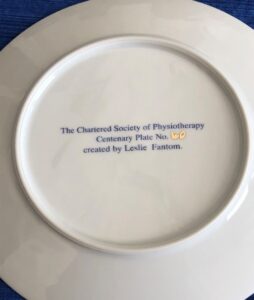
Figure 2
Armorial Bearings and Coat of Arms
The precursor “device” to the armorial bearings which formed the origin of the Coat of Arms was first created in 1920.
The coat of arms of the Chartered Society of Massage and Medical Gymnastics (as it was then known) was designed following an appeal for ideas in the Society’s Journal. The design that was adopted at that time comprised an arm holding a glass ball, with a lion, a lily and wall bars and a shield with a black chevron. It was not, however, a fully authorised official design. This was the first reference in the literature to a badge of the Chartered Society. The illustration (Figure 3) also records the royal patronage by Queen Mary from 1916, of the Incorporated Society of Trained Masseuses, which in 1920 became the Chartered Society of Massage and Medical Gymnastics on the granting of the Royal Charter.
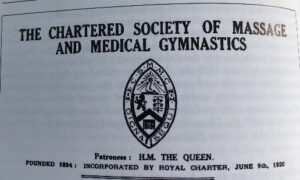
Figure 3
When the patent for the coat of arms expired in 1937, Council was advised that the best way to protect its device against unauthorised use would be to acquire a proper coat of arms. The Grant of Arms was presented in 1938 and is signed and sealed by the Garter, Clarenceux and Norroy – Kings of Arms. Clarenceux, King of Arms, (often historically spelt “Clarencieux) is an officer at the College of Arms in London. Clarenceux is the senior of the two provincial kings of arms and his jurisdiction is England and Wales. The office almost certainly existed in 1420.
Out went the gymnastics ladder (possibly too humble for a heraldic symbol) and the lily of purity but the motto, the lions, the hands and the radiating glass ball depicting electrotherapy survived. The lions stand for royalty and symbolised the patronage of the Queen and the Royal Charter. The two hands represent the “craft” of the physiotherapist.
Official Description – “Or on a Chevron sable between three lions rampant; Gules a sinister and a dexter arm embowed proper vested above the elbow azure, the hand grasping a glass sphere irradiated also proper.” (or – gold, sable – black, gules – red, proper – natural colour, eg pink for a hand).
Fellowship
A Member of the Chartered Society of Physiotherapy awarded Fellowship, the highest honour awarded by the Society, is presented with a hall marked silver CSP badge hung on a silver fastening bar (Figure 4) which the Fellow is entitled to wear at CSP functions.
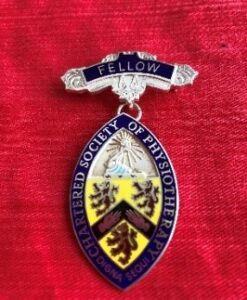
Figure 4
The idea of awarding fellowships for written research that advanced the cause of physiotherapy and Honorary Fellowships for service to the Society had been raised during the World War II and in 1947, a Fellowship Advisory Board was set up. Within two years after approval of their projects candidates were required to submit to three assessors a thesis of higher degree standard of 5000 words or more, including two full case studies. The submission cost was £25 – a sizeable chunk out of an average physiotherapy salary of about £400 per year, at that time. In 1948, the Council decided to award the first honorary fellowships to Miss Jane Honora Wicksteed, author of the well-known early history of physiotherapy – “The Growth of a Profession: Being the history of the Chartered Society of Physiotherapy 1894-1945”, Doctor James Mennell and Doctor Justina Wilson. The second group of honorary Fellows had been members of the first Chartered Society of Massage and Medical Gymnastics Council. By December 1955, fifteen members had been awarded fellowships for books or theses. By 1981, only 27 fellowships and 31 honorary fellowships had been awarded. The council accepted the Fellowship Advisory Board’s recommendation that in future peer nomination and analysis of the curriculum vitae and other evidence should be the main route to fellowships, with academic submission mainly reserved for members who could not easily register for a degree with a university. At that time physiotherapy had not yet become an all degree profession, so access to university higher degree study was always accessible.
Vice President
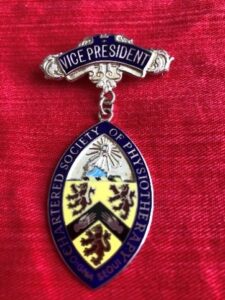
Figure 5
The office and honour of invitation to serve the Chartered Society of Physiotherapy as a Vice President was, and still is bestowed by the CSP Council to members who have given outstanding or exceptional service to the profession of physiotherapy and the CSP over a sustained period. Vice presidency is for a specified period of two years and may be exceptionally extended by a further two years. It is an honour, and also Vice Presidents may fulfill roles supporting or standing in for the President, on occasions, when they are unable to undertake presidential duties. Vice Presidents may also fulfill other roles in support of the work of the Council or Society. The Vice President Insignia is a silver CSP badge hung on a hallmarked silver bar (Figure 5) which is worn on Vice Presidential official duties or at CSP functions.
The Outgoing Chair of Council Award

Figure 6
This is a small lozenge shaped hallmarked gold badge (Figure 6) which is presented by the CSP Council on behalf of the Society to every outgoing Chair of Council on completion of their term of office and as a token of thanks for their service. The badge is a replica, in hallmarked gold, of the CSP badge engraved on the back with the CSP register number of the recipient. The holder is entitled to wear the gold badge at any CSP or physiotherapy meeting or function. The tradition of presenting this award started in the early 1990s.
The CSP Membership Badge for Physiotherapy Graduates
On graduating and joining the Chartered Society of Physiotherapy new members are given a CSP badge. Until the 1980s, the lozenge-shaped badge was made of bronze with the physiotherapist’s CSP register number engraved on the back. Therefore, the badge was unique to the individual. Since that time the badge has gone through various iterations of manufacture materials, although the design is identical. The badge bears the CSP motto “Digna Sequi”- follow worthy things.
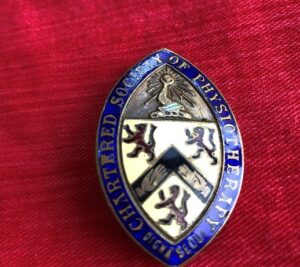
Figure 7

Figure 8
Figure 9 depicts an original badge of the CSMMG (1920) with the motto Digna Sequi and is made of enamel. t belonged to member 799 as witness the engraving on the reverse (Figure 10).

Figure 9
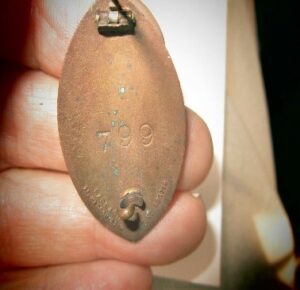
Figure 10
The Council for Professions Supplementary to Medicine (CPSM) and The Health Professions Council (now the Health and Care Professions Council) – HCPC
Under the provisions of the Professions Supplementary to Medicine Act of Parliament,1960 physiotherapists working in the National Health Service were required to be State Registered. State Registration for physiotherapists and the other six professions
- Chiropodists (now known as podiatrists)
- Dieticians
- Medical Laboratory Scientific Officers
- Occupational Therapists
- Orthoptists
- Radiographers
was administered by the Council of Professions Supplementary to Medicine (CPSM). A separate registration Board existed for each profession within CPSM with the power to:
- Identify and register those competent to practice and to publish a Register each year
- Regulate and approve the standard of qualification, examinations and training
- Publish and implement standards of professional conduct and disciplinary procedures which led, when necessary, to those guilty of misconduct being struck off and prevented from practising in the NHS
Towards the end of the 20th century the Allied Health Professions and the CPSM, campaigned strongly to make changes to State Registration and to protect professional titles. The need for protection of title by law had long been widely recognised as necessary for protection of the public from non-qualified practitioners. t was generally recognised that there was a wide-ranging need to bring the CPSM rules up-to-date, especially in the area of fitness to practice and in-line with Government policy on regulation of public services.
Consequently, after much debate there was, in the mid-1990s, an independent review of the Professions Supplementary to Medicine Act and in 1998 the Government published its findings on what it expected of regulatory bodies in future.
The CPSM Act was repealed, and the Health Professions Order 2001 established the new Health Professions Council (HPC). Interestingly, the establishment of the new HPC was legislated for through the mechanism of Statutory Instruments as Secondary Legislation rather than by presentation of a Bill and Act of Parliament. Secondary Legislation in the UK is debated and passed by Parliament and then approved by the Privy Council to become law.
The new HPC consisted of the Council with four statutory committees and five non-statutory committees were also included to assist the Council in discharging its function as a Regulator. The Council comprised both registrant members and lay members (a new innovation). he principle underpinning the total number of members on the Council was that the number of registrant members should always exceed the number of lay members by one, a very slender majority. Each profession was to have one member from its part of the register and an alternate member who acted as a full member of the Council in the absence of the registrant member. Lay members were defined as people not on any register nor could they have ever been so, they came from a wide range of expertise and were appointed by the Privy Council. he four Statutory Committees were: Education and Training, Investigating, Conduct and Competence and Health. When the HPC was formed there were initially five non-Statutory Committees: Finance and Resources, Audit, Communications, Registration and Approvals Committee. The first President of the Council, although a physiotherapist by background, was an educator with strictly no responsibility for representing the physiotherapy profession.
The main purposes of the HPC were:
- Approval of programmes of education and training for entry to the Register
- Establishing and operating a Register
- Setting standards
- Intervening where a registrant’s fitness to practice was alleged to be below standard
Initially there were 12 professions on the HPC including physiotherapy and since the HPC was set up this has increased to include social care and other professions in healthcare and consequently the HPC is now known as the Health and Care Professions Council. he HPC has been found to be a useful template for the development of regulatory structures by several countries.
Personal Involvement with the CPSM and HPC
From 1995 the author was a nationally elected member of the CPSM serving a term of office on the Registration Committee and chairing the Investigation Committee in a further term of office. When the HPC was formed in shadow form in 2000/2001 was nominated by the Secretary of State for Health, on the recommendation of the CSP, to be the physiotherapy registrant member continuing in the role when HPC became fully operational in 2002 serving on the Registration Committee.
Official Commemorative Gifts
On the closure of the CPSM each Board member was presented with a commemorative gift, a crystal paperweight which is inscribed “CPSM 1960 – 2002” (Figure 11).
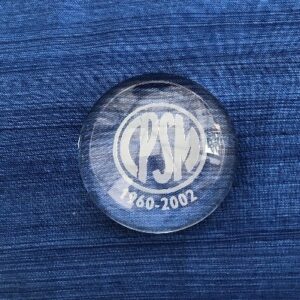
Figure 11
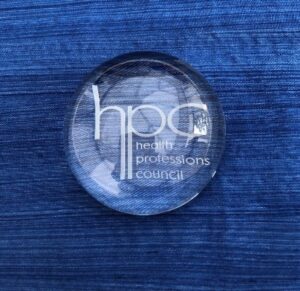
Figure 12
Similarly on the inauguration of the HPC each member of the Council was presented with an official commemorative gift inscribed – “HPC: Health Professions Council” (Figure 12).
References:
CSP Centenary Journal, January 1994. Vol.80, no,A
Barclay, J. 1994 In Good Hands. Oxford: Butterworth-Heinemann Ltd
Jones, R.J. 1987 in CSP Source Book. Norwich: Park Sutton Publishing
Jones, R. J. 1991. Management in Physiotherapy. Oxford: Radcliffe Medical Press Ltd.
Jones, R; Jenkins, F. 2006. Managing and Leading in the Allied Health Professions – Allied Health
Professions Essential guides. Oxford: Radcliffe Publishing Ltd. Now available from Taylor and Francis or Amazon.

